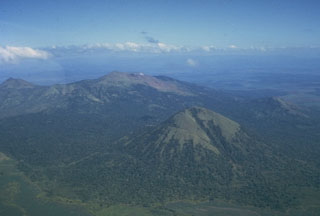Report on Las Pilas-El Hoyo Complex (Nicaragua) — September 1993
Bulletin of the Global Volcanism Network, vol. 18, no. 9 (September 1993)
Managing Editor: Edward Venzke.
Las Pilas-El Hoyo Complex (Nicaragua) Weak fumarolic activity
Please cite this report as:
Global Volcanism Program, 1993. Report on Las Pilas-El Hoyo Complex (Nicaragua) (Venzke, E., ed.). Bulletin of the Global Volcanism Network, 18:9. Smithsonian Institution. https://doi.org/10.5479/si.GVP.BGVN199309-344080
Las Pilas-El Hoyo Complex
Nicaragua
12.4922°N, 86.6786°W; summit elev. 1088 m
All times are local (unless otherwise noted)
A continuous white plume from El Hoyo was easily visible at distances of 5-10 km from the volcano throughout the entire first week of September.
Geological Summary. Las Pilas-El Hoyo volcanic complex, overlooking Cerro Negro volcano to the NW, includes a diverse cluster of cones within about a 3-km-diameter area. A N-S-trending fracture system cutting across the edifice is marked by numerous flank vents, including maars, that are part of a 30-km-long volcanic massif. The Cerro Negro chain of cinder cones is listed separately in this compilation because of its extensive historical eruptions and possible distinct magmatic system. The lake-filled Asososca maar is located adjacent to the Cerro Asososca cone on the southern side of the fissure system, south of the axis of the Marrabios Range. Two small maars west of Lake Managua are located at the southern end of the fissure. Aside from a possible eruption in the 16th century, eruptions of Las Pilas took place in the 1950s from a fissure that cuts the eastern side of the 700-m-wide crater and extends down the N flank.
Information Contacts: Michael Conway and Andrew Macfarlane, FIU; Charles Connor, CNWA Bldg. 168, Southwest Research Institute, 6220 Culebra Road, San Antonio, TX 78228-0510; Oscar Leonel Urbina and Cristian Lugo, INETER.

